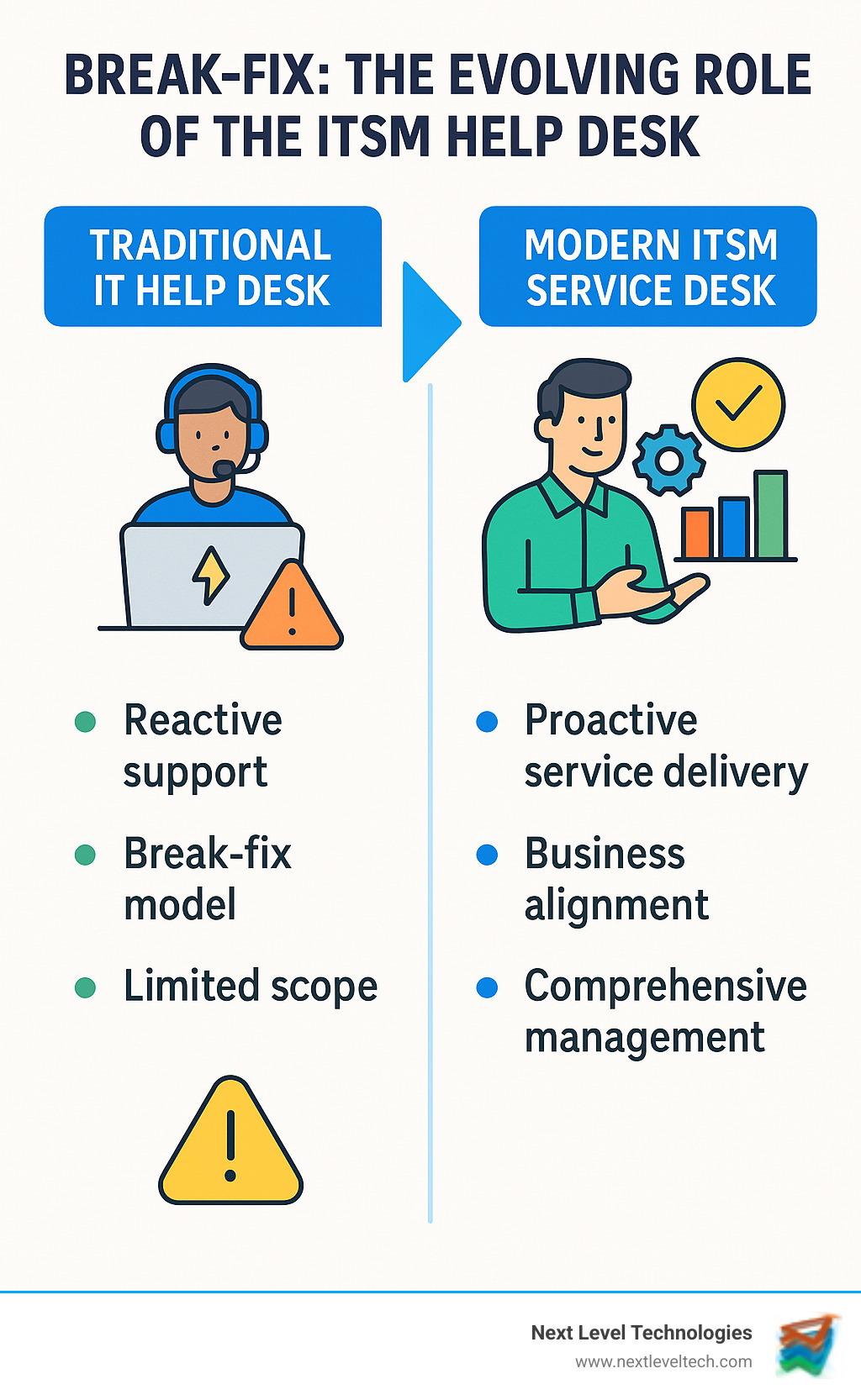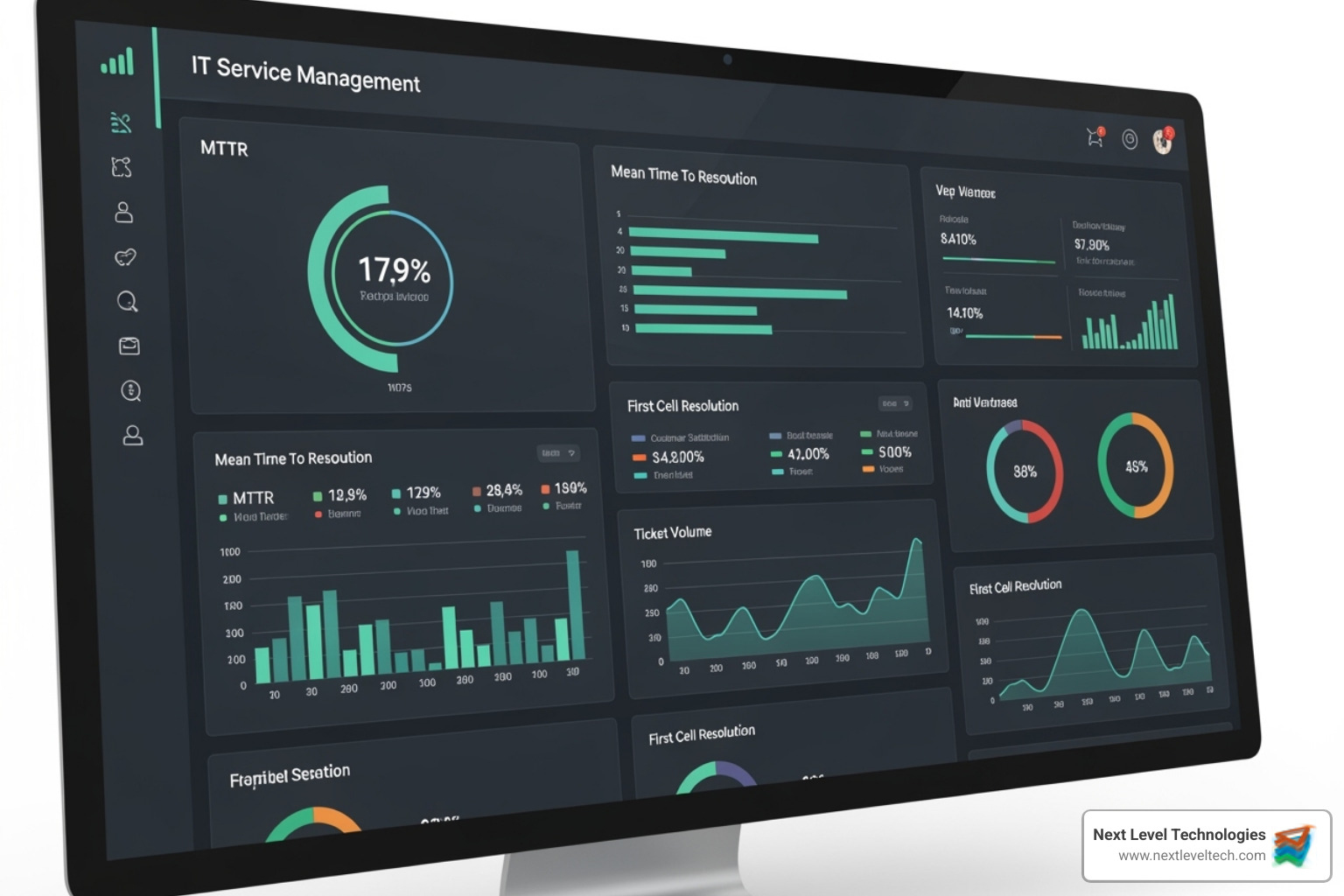Beyond Break-Fix: The Evolving Role of the ITSM Help Desk
August 12, 2025

Discover the ins and outs of remote access solutions. Enhance productivity, fortify security, and empower your remote workforce.
December 30, 2025

Launch your IT support for business startup! Get a complete blueprint for success, from market research to client acquisition and cybersecurity.
December 26, 2025

Master comprehensive IT support. Prevent downtime, fortify security, and empower growth with proactive managed services. Find your perfect partner.
December 25, 2025
August 12, 2025
An ITSM help desk is a strategic approach to IT service management that delivers comprehensive services aligned with business goals, moving beyond simple break-fix support. Unlike traditional help desks that react to problems, ITSM help desks proactively manage the entire IT service lifecycle.
Key differences between ITSM Help Desk and traditional Help Desk:
The simple "break-fix" IT support model is outdated. Businesses now require strategic IT partners who understand that every technical interaction impacts business productivity. Industry research shows organizations face 236% more tickets with only a 63% increase in IT engineers, forcing a shift in IT support strategy. The solution is evolving from reactive help desks to proactive service desks that prevent problems before they occur.
At Next Level Technologies, we've spent over 15 years helping businesses in Columbus, Ohio, and Charleston, WV, transform their IT operations with strategic ITSM help desk implementations. Our team's extensive cybersecurity training and deep technical experience have shown that successful organizations treat their service desk as a strategic business asset, not a cost center.

The terms "help desk" and "service desk" are often used interchangeably, but within IT Service Management (ITSM), they have distinct meanings. They represent two different philosophies for delivering IT support.
ITSM, or Information Technology Service Management, is a strategic approach to managing all IT services from design to support. It's a comprehensive philosophy that treats IT as a valuable service aligned with business functions. You can learn more in our detailed article: Define ITSM.
The primary difference between a help desk and a service desk is their focus: tactical versus strategic. This distinction impacts how users get help and how IT integrates with broader business goals.
| Attribute | IT Help Desk | IT Service Desk |
|---|---|---|
| Scope | Narrow, focused on specific issues | Broad, covers entire service lifecycle |
| Primary Goal | Reactive problem-solving, "break/fix" | Proactive service delivery, user enablement |
| Processes Handled | Incident management, basic requests | Incident, service request, problem, change, knowledge management |
| Business Alignment | Tactical, IT-centric | Strategic, business-centric, aligns IT with business goals |
A traditional IT help desk is a tactical, reactive support function. Its main purpose is to resolve immediate technical problems and restore service as quickly as possible, a model often called "break/fix". The core responsibility is incident management—logging, tracking, and resolving individual IT issues. This is an IT-centric approach, where success is typically measured by how quickly a ticket is closed. While essential for immediate fixes, this reactive model can feel like constantly putting out fires without addressing the cause.
An IT service desk is an evolution of the help desk, built on ITSM principles. It is a strategic, proactive, and service-oriented function that acts as the Single Point of Contact (SPOC) between users and the IT department. It goes beyond break-fix to manage IT as a holistic service, aiming to understand the root cause of issues to prevent recurrence.
A service desk handles a much wider range of activities, including:
The service desk emphasizes the user experience and aligns IT services with business objectives to boost productivity. This strategic approach is often guided by frameworks like ITIL, which provides best practices for ITSM.
At Next Level Technologies, our deep technical experience and extensive cybersecurity training help businesses in Columbus, OH, and Charleston, WV, transform their IT. We guide them from a reactive fix-it model to a strategic service delivery model. A true ITSM help desk ensures technology actively supports and improves your entire business operation.
A well-implemented ITSM help desk functions as a strategic engine for your business, driving efficiency, improving productivity, and delivering significant cost savings.
At Next Level Technologies, our deep technical experience and extensive cybersecurity training have shown us how a strategic approach to IT support transforms organizations in Columbus, Ohio, and Charleston, WV.

The benefits of an ITSM help desk extend beyond faster computer fixes to include tangible efficiency gains, improved productivity, and cost savings. Learn more about how strategic IT support impacts your bottom line in our article on The Different Ways That IT Help Desk Can Save You Time and Money.
A modern ITSM help desk handles a diverse set of tasks to ensure a smooth and secure IT environment.
The strategic advantages of a robust ITSM help desk are game-changing for any business.
A well-structured ITSM help desk transforms IT from a cost center into a strategic partner that actively drives business success.
Implementing or improving an ITSM help desk involves overcoming common challenges like resistance to change, limited resources, and complex integrations. A smart strategy and commitment to continuous improvement are key. At Next Level Technologies, our experience with managed IT services for businesses in Columbus, Ohio, and Charleston, WV, provides the expertise needed for smooth IT Incident Management.
A modern ITSM help desk relies on several core components for effective support:
Having the right components is only the first step; implementing best practices ensures your ITSM help desk excels:
Combining the right tools with these practices transforms your ITSM help desk from a cost center into a proactive, value-generating asset.
The IT support landscape is rapidly evolving, with the ITSM help desk at the forefront. Artificial Intelligence (AI) and automation are now integral to modern service delivery, making support smarter and more efficient. We are constantly exploring The Latest Innovations in IT Support Technology for 2024 to provide our clients with cutting-edge solutions.

AI and automation enable routine tasks to be handled instantly and potential problems to be predicted, allowing IT teams to focus on complex, strategic initiatives.
Automation handles mundane, repetitive tasks, freeing up human agents to tackle more complex issues.
AI adds a layer of intelligence and prediction to the service desk. Our technical experience and extensive cybersecurity training ensure we implement these AI solutions securely and effectively.
The integration of AI and automation into the ITSM help desk empowers IT teams to be more strategic and ensures your business operates at peak performance.
Here are answers to some of the most common questions about the evolution of IT support and the role of the service desk.
While the terms are often used interchangeably, their functions are distinct. A traditional help desk is tactical and reactive, focused on fixing immediate IT issues using a "break-fix" model. Its primary goal is to restore service quickly.
In contrast, a service desk is proactive and strategic. It manages the entire lifecycle of IT services to align them with business goals. It handles not only incidents (break-fix) but also service requests (e.g., new software or system access), focusing on the overall user experience and continuous improvement.
The most critical function is serving as the Single Point of Contact (SPOC) between users and the IT department. This centralization is vital because it streamlines communication and ensures consistent service delivery. It provides a clear, unified path for users to get the help they need, which saves time, reduces frustration, and improves productivity.
An ITSM help desk directly improves business outcomes in several key ways. It increases employee productivity by resolving issues faster and minimizing downtime, allowing staff to focus on core tasks. It also helps align IT services with business objectives, ensuring technology investments support strategic goals. Finally, it provides valuable data through reporting and analytics, enabling informed decision-making to optimize processes and reduce costs. The result is greater operational efficiency, lower IT costs, and improved user satisfaction, all contributing to a stronger bottom line.
The evolution from a simple "break-fix" model to the sophisticated, strategic ITSM help desk marks a significant change in IT support. Modern IT is no longer just about fixing what's broken; it's a powerful strategic asset that drives business forward. This fundamental shift towards proactive, goal-aligned IT empowers users, creates business value, and leads to smoother operations.
At Next Level Technologies, we are passionate about the power of a well-implemented ITSM help desk. We have seen how it transforms businesses, turning IT from a necessary expense into a competitive advantage.
Based in Columbus, Ohio, with a strong presence in Charleston, WV, we provide comprehensive IT solutions to businesses of all sizes. Our team leverages its deep technical experience and a proactive approach to every challenge. With our extensive cybersecurity training, we ensure your systems are not just running smoothly, but are also secure. We focus on preventing problems to help your IT operations perform at their peak.
Don't settle for reactive IT support. Accept the strategic power of an ITSM help desk to lift your business. Ready to take your IT to the next level? Find how our managed IT services can make a difference. Visit us at Managed IT Services and IT Support to build a more efficient future for your business.
Discover the ins and outs of remote access solutions. Enhance productivity, fortify security, and empower your remote workforce.
December 30, 2025
Launch your IT support for business startup! Get a complete blueprint for success, from market research to client acquisition and cybersecurity.
December 26, 2025
Next Level Technologies was founded to provide a better alternative to traditional computer repair and ‘break/fix’ services. Headquartered in Columbus, Ohio since 2009, the company has been helping it’s clients transform their organizations through smart, efficient, and surprisingly cost-effective IT solutions.
